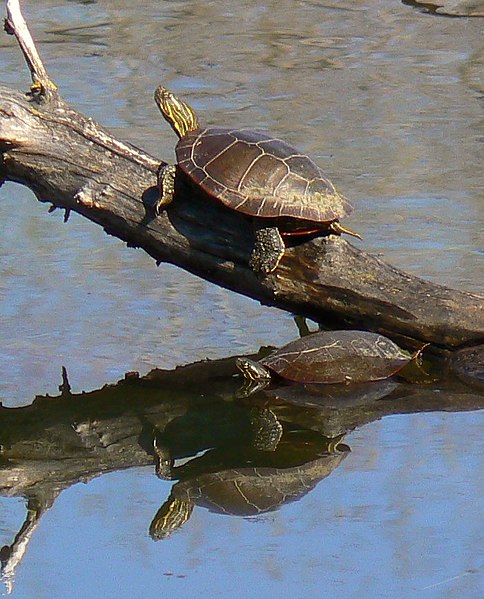 While usually sold as a decoration for tropical fish aquariums, driftwood that has been anchored to a slate base also makes an excellent sub-surface platform for those herps that do not usually
While usually sold as a decoration for tropical fish aquariums, driftwood that has been anchored to a slate base also makes an excellent sub-surface platform for those herps that do not usually
leave the water completely when resting or basking (i.e. Musk, Softshelled and Mud Turtles, Snappers, Newts, African Clawed Frogs). It also serves well as a “staircase” for hatchling turtles, many of which weaken quickly when force to swim to the surface for air in deep aquariums. Please see Part 1 of this article for detailed information on these topics.
Using Driftwood
Driftwood can be used on bare-bottomed tanks (this simplifies the cleaning of turtle aquariums) or those with a gravel substrate and, unlike most woods, will not stain the water by leaching tannins. An endless array of shapes and sizes is available, so most any tank depth or species can be accommodated.
Long, sloping lengths of wood make ideal basking platforms, while bases with multiple pieces attached provide a variety of levels for your animals to experiment with. If a dry basking site is needed, you can arrange for part of the wood to break the water’s surface (please see photo of Painted Turtle resting on wood)…weathered wood is gentle on turtle plastrons and amphibian skin, and much preferable to rock.
Live Plant Possibilities
Driftwood looks wonderful when interspersed among live plants. I love to create shoreline aquariums by using driftwood as an anchoring site for Pothos, Peace Lilies and other emergent plants. As you can see from the attached photo, thick beds of plant roots draped over driftwood can be used to create a naturalistic and beneficial resting area for small turtles, frogs, metamorphosing tadpoles and newts.
Aquatic and Semi-Aquatic Amphibians
Newts, Green Frogs and other semi-aquatic species usually rest while partially in water in the wild, and will readily utilize pieces of driftwood that rise to, or just below, the water’s surface. Fully aquatic frogs and salamanders may also benefit – I’ve even seen African Clawed Frogs clamber onto a sloping wood ramp to snatch a cricket (as surprising to me as those films of killer whales beaching themselves when chasing penguins)!
I’ve also found driftwood to be very useful when rearing tadpoles…most species will rest just below the surface very frequently as they transform, and will then climb out of the water as their tails shrink.
You can use rocks for the purposes described above, but they take up a great deal of “swimming room”, may leach harmful minerals, and most are rough on turtle carapaces and amphibian skin.
Types Available
 Driftwood is available with single or multiple pieces attached to one base, and comes in sizes ranging from 8 to 20+ inches.
Driftwood is available with single or multiple pieces attached to one base, and comes in sizes ranging from 8 to 20+ inches.
Sinking African Mopani Wood can be used as a submerged compliment to upright pieces of Driftwood.
Further Reading
Mud and Musk Turtle Care and Natural History
Notes on Snapping Turtle Basking Behavior, in and out of water.
 That Reptile Blog – Reptile, Amphibian and Exotic Pet Care and Information
That Reptile Blog – Reptile, Amphibian and Exotic Pet Care and Information



I also like to add maiden’s hair fern too.
Good article, Frank.
Hello Scott, Frank Indiviglio here.
Thanks for the kind words. Great idea, I have it growing in many tanks, should have added it to list in article. My newts and aquatic frogs make good use of it, great as a shelter for tads, fishes also,
Best regards, Frank Indiviglio.
Great article!
Can you kindly refer me to a decent article as how to keep/culture these fern. They are sold in our country as well, but I did not know they can be used for aquarium as well…meaning I changed the closed lid of my 500Ltr aquarium to an OPEN one. Now I added a few creeping plants as to decorate my wall behind the aquarium. Obvious such an fern would ad to a beautiful visual effect!
Best fishes
Gert
Hello Gert, Frank Indiviglio here.
Thanks for your note; sorry, my post might have been misleading. This fern is suited to aqua-terrariums that have a land area. It grows well in wet soil, and the broad leaves can be arranged to lie on the surface of the water, where they will be used by small amphibians. But it does not do well submerged, as do some houseplants (peace lily) as far as I know. This article addresses their care. There is a fast-growing algae that aquarists here often refer to, casually, as the maiden’s hair as well. It just seems to “appear” in some tanks, a great addition but very aggressive.; unfortunately I have not looked into its proper name.
Please let me know if you need any further information. Good luck, enjoy and please keep me posted.
Best regards, Frank Indiviglio.